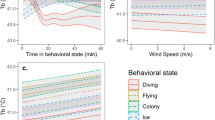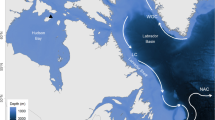Abstract
The aim of the present study was to evaluate, for the first time, the effect of environmental warming on the metabolic and behavioral ecology of a temperate seahorse, Hippocampus guttulatus. More specifically, we compared routine metabolic rates, thermal sensitivity, ventilation rates, food intake, and behavioral patterns at average spring temperature (18 °C), average summer temperature (26 °C), temperatures that they endure during summer heat wave events (28 °C), and in a near-future warming scenario (+2; 30 °C) in Sado estuary, Portugal. Both newborn juveniles and adults showed significant increases in metabolic rates with rising temperatures. However, newborns were more impacted by future warming via metabolic depression (i.e., heat-induced hipometabolism). In adult stages, ventilation rates also increased significantly with environmental warming, but food intake remained unchanged. Moreover, the frequency of swimming, foraging, swinging, and inactivity did not significantly change between the different thermal scenarios. Thus, we provide evidence that, while adult seahorses show great resilience to heat stress and are not expected to go through any physiological impairment and behavioral change with the projected near-future warming, the early stages display greater thermal sensitivity and may face greater metabolic challenges with potential cascading consequences for their growth and survival.






Similar content being viewed by others
References
Boutilier RG (2001) Mechanisms of cell survival in hypoxia and hypothermia. J Exp Biol 204:3171–3181
Brierley AS, Kingsford MJ (2009) Impacts of climate change on marine organisms and ecosystems. Curr Biol 19:602–614
Curtis JMR, Vincent ACJ (2005) Distribution of sympatric seahorse species along a gradient of habitat complexity in a seagrass-dominated community. Mar Ecol Prog Ser 291:81–91
Curtis JMR, Vincent ACJ (2006) Life history of an unusual fish: survival, growth and movement patterns of Hippocampus guttulatus Cuvier 1829. J Fish Biol 68:707–733
Dejours P (1973) Problems of control of breathing in fishes. In: Bolis L, Schmidt-Nielson K, Maddrell P (eds) Comparative physiology: locomotion, respiration, transport and blood. North Holland/American Elsevier, New York, pp 117–133
Faleiro F, Narciso L, Vicente L (2008) Seahorse behaviour and aquaculture: how to improve Hippocampus guttulatus husbandry and reproduction? Aquaculture 282:33–40
Ford JMJ, Tibbetts IR, Carseldine L (2004) Ventilation rate and behavioural responses of two species of intertidal goby (Pisces: Gobiidae) at extremes of environmental temperature. Hydrobiologia 528:63–73
Foster SJ, Vincent ACJ (2004) Life history and ecology of seahorses: implications for conservation and management. J Fish Biol 65:1–61
Guppy M, Withers P (1999) Metabolic depression in animals: physiological perspectives and biochemicals generalizations. Biol Rev 74:1–40
Halpern BS, Walbridge S, Selkoe KA, Kappel CV, Micheli F, D’Agrosa C, Bruno JF, Casey KS, Ebert C, Fox HE, Fujita R, Heinemann D, Lenihan HS, Madin EMP, Perry MT, Selig ER, Spalding M, Steneck R, Watson R (2008) A global map of human impact on marine ecosystems. Science 319:948–952
Kennedy VS, Twilley RR, Kleypas JA, Cowan JH Jr (2002) Coastal and marine ecosystems and global climate change: potential effects on U.S. resources. Pew Center on Global Climate Change, Arlington, VA
Koldewey HJ, Martin-Smith KM (2010) A Global review of seahorse aquaculture. Aquaculture 302:131–152
Lenton TM, Held H, Kriegler E, Hall JW, Lucht W, Rahmstorf S, Schellnhuber HJ (2008) Tip** elements in the Earth’s climate system. Proc Natl Acad Sci USA 105:1786–1793
Lin Q, Lu J, Gao Y, Shen L, Cai J, Luo J (2006) The effect of temperature on gonad, embryonic development and survival rate of juvenile seahorses, Hippocampus kuda Bleeker. Aquaculture 254:701–713
Lin Q, Lin J, Zhang D (2008) Breeding and juvenile culture of the lined seahorse, Hippocampus erectus Perry, 1810. Aquaculture 277:287–292
Lin Q, Lin J, Huang L (2009) Effects of substrate color, light intensity and temperature On survival and skin color change of juvenile seahorses, Hippocampus erectus Perry, 1810. Aquaculture 298:157–161
Lin Q, Lin J, Huang L (2010) Effects of light intensity, stocking density and temperature on the air-bubble disease, survivorship and growth of early juvenile seahorse Hippocampus erectus, Perry 1810. Aquac Res 42:91–98
Lourie SA, Foster SJ, Cooper EW, Vincent ACJ (2004) A guide to the identification of seahorses. Project seahorse and TRAFFIC North America. University of British Columbia and World Wildlife Fund, Washington, DC p 114
Love RM (1970) The chemical biology of fishes. Academic Press, London, pp 209–215
Miranda PMA, Coelho FES, Tomé AR, Valente MA (2002) 20th Century Portuguese Climate and Climate Scenarios. In: Santos FD, Forbes K, Moita R (eds) Climate change in Portugal. Scenarios, Impacts and adaptation measures—SIAM Project. Gradiva, Lisboa, pp 27–83
Perry AL, Low PJ, Ellis JR, Reynolds JD (2005) Climate change and distribution shifts in marine fishes. Science 308:1912–1915
Petit JR, Raynaud D, Lorius C (1999) Climate and atmospheric history of the past 420,000 years from the Vostok ice core, Antarctica. Nature 399:429–436
Philipart CJM, Anadón R, Danovaro R, Dippner JW, Drinkwater KF, Hawkins SJ, Oguz T, O’Sullivan G, Reid PC (2011) Impacts of climate change on European marine ecosystems: Observations, expectations and indicators. J Exp Mar Biol Ecol 400:52–69
Pimentel MS, Trübenbach K, Faleiro F, Boavida-Portugal J, Repolho T, Rosa R (2012) Impact of ocean warming on the early ontogeny of cephalopods: a metabolic approach. Mar Biol 159:2051–2059
Pörtner HO, Knust R (2007) Climate change affects marine fishes through the oxygen limitation of thermal tolerance. Science 315:95–97
Pörtner HO, Mark FC, Bock C (2004) Oxygen limited thermal tolerance in fish? Answers obtained by nuclear magnetic resonance techniques. Resp Physiol Neurobiol 141:243–260
Pörtner HO, Langenbuch M, Michaelidis B (2005) Synergistic effects of increased CO2, temperature and hypoxia on marine animals. J Geophys Res 110:C09S10
Roessig MJ, Woodley MC, Cech JJ, Hansen LJ (2004) Effects of global climate change on marine and estuarine fishes and fisheries. Rev Fish Bio Fish 14:251–275
Rosa R, Seibel BA (2008) Synergistic effects of climate-related variables suggest future physiological impairment in a top oceanic predator. Proc Natl Acad Sci 105:20776–20780
Rosa R, Seibel BA (2010) Metabolic physiology of the Humboldt squid, Doisicus gigas: implications for vertical migrations in a pronounced oxygen minimum zone. Prog Oceanogr 86:72–80
Rosa R, Trueblood L, Seibel BA (2009) Ecophysiological influence on scaling of aerobic and anaerobic metabolism of pelagic gonatid squids. Physiol Biochem Zool 82:19–429
Rosa R, Pimentel MS, Boavida-Portugal J, Teixeira T, Trübenbach K, Diniz MS (2012) Ocean warming enhances malformations, premature hatching, metabolic suppression and oxidative stress in the early life stages of a keystone invertebrate. PLoS ONE 7(6):e38282
Russell IA (1994) Mass mortality of marine and estuarine fish in the Swartvlei and Wilderness Lake Systems, Southern Cape. S Afric J Aquat Sci 20:93–96
Santos FD, Forbes K, Moita R (2002) Climate change in Portugal scenarios. Impacts and adaptation measures—SIAM Project. Gradiva, Lisbon
Schmidt-Nielsen K (1997) Animal physiology: adaptation and environment, 5th edn. Cambridge University Press, Cambridge
Sheng J, Lin Q, Chen Q, Gao Y, Shen L, Lu J (2006) Effects of food, temperature and light intensity on the feeding behavior of the three-spot juvenile seahorses, Hippocampus trimaculatus Leach. Aquaculture 256:596–607
Solomon S, Qin D, Manning M, Chen Z, Marquis M, Averyt KB, Tignor M, Miller HL (2007) Contribution of working group I to the fourth assessment report of the intergovernmental panel on climate change. Cambridge University Press, Cambridge. United Kingdom and New York, NY, USA, p 996
Wang T, Overgaard J (2007) The heartbreak of adapting to global warming. Science 315:49–50
Wong JM, Benzie JAH (2003) The effects of temperature, Artemia enrichment, stocking density and light on the growth of juvenile seahorses, Hippocampus whitei (Bleeker, 1855), from Australia. Aquaculture 228:107–121
Acknowledgments
The Portuguese Foundation for Science and Technology (FCT) supported this study through project grant PTDC/MAR/0908066/2008 to R. Rosa.
Author information
Authors and Affiliations
Corresponding author
Additional information
Communicated by U. Sommer.
Appendix
Appendix
See Table 4.
Rights and permissions
About this article
Cite this article
Aurélio, M., Faleiro, F., Lopes, V.M. et al. Physiological and behavioral responses of temperate seahorses (Hippocampus guttulatus) to environmental warming. Mar Biol 160, 2663–2670 (2013). https://doi.org/10.1007/s00227-013-2259-8
Received:
Accepted:
Published:
Issue Date:
DOI: https://doi.org/10.1007/s00227-013-2259-8




